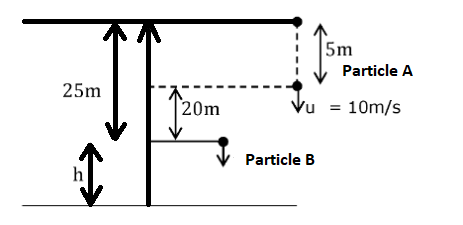
A stone is dropped from the top of a building. When it crosses a point 5m below the top, another stone starts to fall from a point 25m below the top, both stones reach the bottom of the building simultaneously. The height of the building is: [Take g = 10 m/s\[^2\]]
A. 45 m
B. 35 m
C. 25 m
D. 50 m
Answer
219.6k+ views
Hint: Gravity is a fundamental interaction between two objects having a certain mass. It is a form of mutual attraction force between the interacting objects. The force of this mutual attraction depends on the size of the objects and the square of the distance separating them. So far, as known in Physics, Gravitational pull is the weakest known force existing in nature.
Complete step by step solution:

Image: Figure to explain the question
The velocity of the particle (A) at 5m below top
\[{u_1} = \sqrt {2gh} \\ \Rightarrow {u_1} = \sqrt {(2 \times 10 \times 5)} \\ \Rightarrow {u_1} = 10\,m{s^{ - 1}} \\ \]
The second law of motion is denoted by:
\[S = ut + \left( {\dfrac{1}{2}} \right)a{t^2}\]
where, S = Distance Travelled, u = Initial Velocity, t = time taken and a = acceleration.
For a particle (A), using \[{2^{nd}}\] the equation of motion, we get:
\[20 + h = 10t + \left( {\dfrac{1}{2}} \right)g{t^2} - - - - (1)\]
For a particle (B), using \[{2^{nd}}\] the equation of motion
\[h = \left( {\dfrac{1}{2}} \right)g{t^2}\]
Put equation (2) in equation (1), and we get,
\[20 + \left( {\dfrac{1}{2}} \right)g{t^2} = 10t + \left( {\dfrac{1}{2}} \right)g{t^2} \\ \Rightarrow t = 2\,\sec \\ \]
Putting the time value in equation (2), we get:
\[h = \left( {\dfrac{1}{2}} \right)g{t^2} \\ \Rightarrow h = \left( {\dfrac{1}{2}} \right) \times 10 \times {2^2} \\ \therefore h = 20m \]
Hence, the total height of the building is \[\;25 + 20 = 45m\].
Therefore, the correct answer is option A.
Note: The most fundamental principles of an object's motion are described by the equations of motion used in kinematics. In 1D, 2D, and 3D, these equations control how an object moves. Expressions like the position, velocity, or acceleration of an object at different times can be simply calculated using them.
Complete step by step solution:

Image: Figure to explain the question
The velocity of the particle (A) at 5m below top
\[{u_1} = \sqrt {2gh} \\ \Rightarrow {u_1} = \sqrt {(2 \times 10 \times 5)} \\ \Rightarrow {u_1} = 10\,m{s^{ - 1}} \\ \]
The second law of motion is denoted by:
\[S = ut + \left( {\dfrac{1}{2}} \right)a{t^2}\]
where, S = Distance Travelled, u = Initial Velocity, t = time taken and a = acceleration.
For a particle (A), using \[{2^{nd}}\] the equation of motion, we get:
\[20 + h = 10t + \left( {\dfrac{1}{2}} \right)g{t^2} - - - - (1)\]
For a particle (B), using \[{2^{nd}}\] the equation of motion
\[h = \left( {\dfrac{1}{2}} \right)g{t^2}\]
Put equation (2) in equation (1), and we get,
\[20 + \left( {\dfrac{1}{2}} \right)g{t^2} = 10t + \left( {\dfrac{1}{2}} \right)g{t^2} \\ \Rightarrow t = 2\,\sec \\ \]
Putting the time value in equation (2), we get:
\[h = \left( {\dfrac{1}{2}} \right)g{t^2} \\ \Rightarrow h = \left( {\dfrac{1}{2}} \right) \times 10 \times {2^2} \\ \therefore h = 20m \]
Hence, the total height of the building is \[\;25 + 20 = 45m\].
Therefore, the correct answer is option A.
Note: The most fundamental principles of an object's motion are described by the equations of motion used in kinematics. In 1D, 2D, and 3D, these equations control how an object moves. Expressions like the position, velocity, or acceleration of an object at different times can be simply calculated using them.
Recently Updated Pages
Chain and Position Isomerism Important Concepts and Tips for JEE

JEE Main 2021 July 20 Shift 2 Question Paper with Answer Key

Froth Flotation Principle and Process Important Concepts and Tips for JEE

JEE Main 2022 (June 27th Shift 2) Physics Question Paper with Answer Key

Covalent Character in Ionic Compounds Important Concepts for JEE

JEE Habers Process for Manufacture of Ammonia Important Concepts and Tips

Trending doubts
JEE Main 2026: Application Form Open, Exam Dates, Syllabus, Eligibility & Question Papers

Understanding Uniform Acceleration in Physics

Derivation of Equation of Trajectory Explained for Students

Hybridisation in Chemistry – Concept, Types & Applications

Understanding the Angle of Deviation in a Prism

Understanding Collisions: Types and Examples for Students

Other Pages
JEE Advanced Marks vs Ranks 2025: Understanding Category-wise Qualifying Marks and Previous Year Cut-offs

Units And Measurements Class 11 Physics Chapter 1 CBSE Notes - 2025-26

NCERT Solutions For Class 11 Physics Chapter 8 Mechanical Properties Of Solids

Motion in a Straight Line Class 11 Physics Chapter 2 CBSE Notes - 2025-26

NCERT Solutions for Class 11 Physics Chapter 7 Gravitation 2025-26

Mechanical Properties of Fluids Class 11 Physics Chapter 9 CBSE Notes - 2025-26




